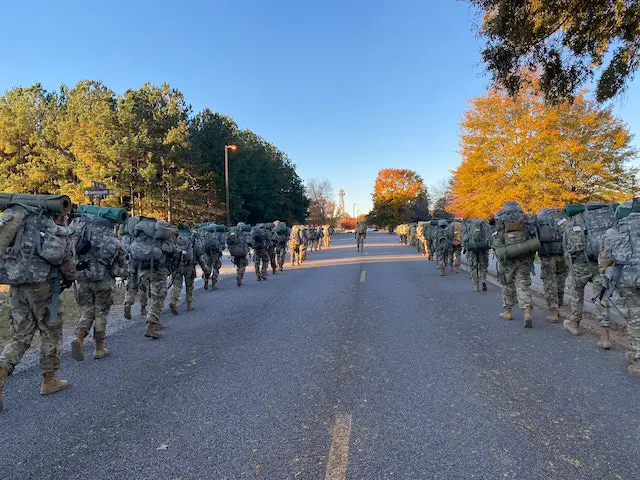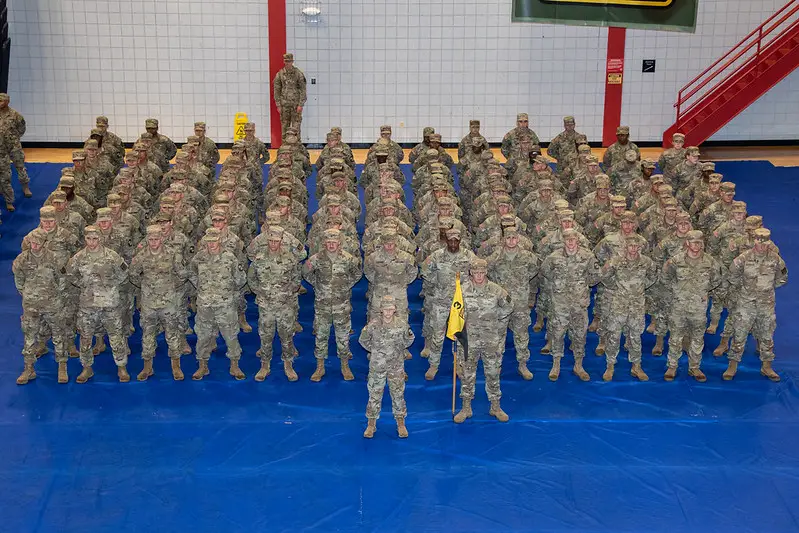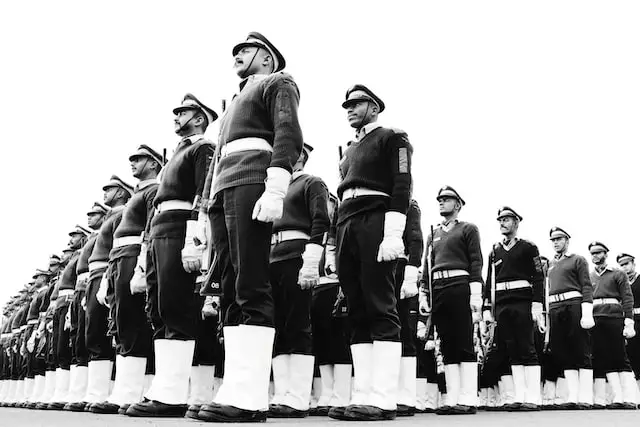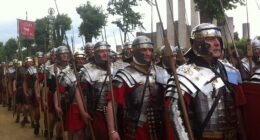Battalion and regiment are two military terms that are often used interchangeably but refer to different levels of organization within a military force. These terms are essential for understanding the structure and hierarchy of any military force. A battalion is a military unit typically composed of 300 to 800 soldiers and is usually commanded by a lieutenant colonel. A regiment, on the other hand, is a military unit typically composed of several battalions and is usually commanded by a colonel.

A battalion is a military unit composed of a number of companies, typically consisting of 300 to 800 soldiers. Battalions are the smallest self-contained unit capable of independent operations, and they are typically commanded by a lieutenant colonel. The term “battalion” is used in many different military organizations, including the army, marine corps, and air force.
What is a Regiment
(U.S. Army Cadet Command (Army ROTC) on Flickr)

A regiment is a military unit that is larger than a battalion and typically consists of several battalions. Regiments are usually commanded by a colonel and are the primary unit of organization in most armies. Regiments are typically responsible for recruiting, training, and organizing their constituent battalions, as well as providing support and supplies for them.
Structure of Regiment
A regiment is structured similarly to a battalion, but on a larger scale. A regiment is typically composed of several battalions, each of which is structured into companies, platoons, and squads or sections. The regiment provides overall leadership and support for the constituent battalions, as well as coordinating their actions during operations.
Structure of Battalion
A battalion is typically structured into companies, with each company consisting of several platoons. The platoons are then divided into smaller units called squads or sections. The structure of a battalion can vary depending on the specific needs of the military organization, but the basic structure remains the same.
Role of Battalion in Military Operations
Battalions play a critical role in military operations. They are responsible for executing the tactical plan set forth by higher command, and they are the primary unit of maneuver in most military operations. Battalions are also responsible for providing their own support and supplies, and they typically have a support unit attached to them for this purpose.
For example a battalion might be tasked with securing a key town or village in a combat zone, engaging enemy forces, and providing intelligence and other support to higher-level units. The commanding officer of the battalion, usually a lieutenant colonel, is responsible for overseeing all operations and personnel within the unit.
Role of Regiment in Military Operations
Regiments also play a critical role in military operations, but on a larger scale. Regiments provide the overall leadership and support for the battalions under their command, and they are responsible for coordinating the actions of these battalions during operations. Regiments also provide support and supplies for their constituent battalions, and they typically have a larger support unit attached to them for this purpose.
For example a regiment might be responsible for providing training and professional development to soldiers, ensuring that they are physically and mentally prepared for deployment. The commanding officer of the regiment, usually a colonel or higher, is responsible for overseeing all aspects of the unit’s operations, from personnel management to logistical support.
The difference between a battalion and a regiment
A battalion is a unit of the armed forces that typically consists of 300 to 1,000 soldiers. A regiment, on the other hand, is a military unit that typically consists of 2,000 to 5,000 soldiers. The main difference between a battalion and a regiment is their size; a battalion is significantly smaller than a regiment. Another difference between the two units is that a battalion is typically led by a colonel, while a regiment is typically led by a general.
Battalions are the smallest self-contained unit capable of independent operations, while regiments are larger units that provide leadership and support for the battalions under their command.
Battalions are responsible for executing the tactical plan set forth by higher command, while regiments provide the overall leadership and support for the battalions under their command and coordinate their actions during operations.
How many soldiers are in a battalion and regiment?
A battalion is typically composed of 300 to 800 soldiers and is divided into a number of companies. A regiment, on the other hand, is larger, with around 3,000 to 5,000 soldiers. It is also divided into a number of companies, but these are usually larger than those in a battalion.
What are the units of an army?
An army is typically composed of several different units, including:
- Division: A large military formation typically consisting of several brigades and numbering 10,000 to 20,000 soldiers.
- Brigade: A military formation typically consisting of several battalions and numbering 3,000 to 5,000 soldiers.
- Battalion: A military unit typically consisting of several companies and numbering 300 to 800 soldiers.
- Company: A military unit typically consisting of several platoons and numbering 100 to 250 soldiers.
- Platoon: A military unit typically consisting of several squads and numbering 20 to 50 soldiers.
- Squad: A military unit typically consisting of several soldiers and numbering 8 to 12 soldiers.
- Special Forces: Elite military units trained in unconventional warfare, reconnaissance, and direct-action missions.
- Support Units: Military units responsible for providing various forms of support to combat units, such as medical, logistics, communications, and engineering units.
- Division: A large military formation typically consisting of several brigades and numbering 10,000 to 20,000 soldiers. The division is typically commanded by a major general and is responsible for carrying out operations on the battlefield.
- Corps: A military formation consisting of two or more divisions and numbering 50,000 to 100,000 soldiers. The corps is typically commanded by a lieutenant general and is responsible for coordinating the actions of multiple divisions in the field.
- Field Army: A military formation consisting of two or more corps and numbering 100,000 to 200,000 soldiers. The field army is typically commanded by a general and is responsible for conducting large-scale operations on the battlefield.
These units can vary in size and composition depending on the country and branch of military service.
What are the ranks of a regiment?
A regiment is typically made up of a number of battalions, each under the command of a lieutenant colonel. The colonel of the regiment is in charge of all the battalions under his or her command. The ranks within a regiment are:
- Colonel: The commanding officer of the regiment, responsible for overseeing all operations and personnel.
- Lieutenant Colonel: The second-in-command of the regiment, responsible for assisting the colonel and assuming command in their absence.
- Major: A senior officer in the regiment, typically in charge of one or more battalions.
- Captain: A junior officer in the regiment, typically in charge of a company (a subunit of a battalion).
- Lieutenant: A junior officer in the regiment, typically serving as a second-in-command of a company.
- Sergeant Major: The senior enlisted advisor to the commanding officer, responsible for overseeing the enlisted personnel and ensuring the smooth operation of the regiment.
- First Sergeant: The senior enlisted advisor to the company commander, responsible for the morale, welfare, and discipline of the enlisted personnel.
- Staff Sergeant: A senior non-commissioned officer in the regiment, responsible for supervising a section or squad.
- Sergeant: A non-commissioned officer in the regiment, responsible for supervising a squad or team of soldiers.
- Corporal: A non-commissioned officer in the regiment, responsible for leading a small group of soldiers and carrying out orders from higher-ranking officers.
- Private: The lowest rank in the regiment, typically a basic enlisted soldier with little or no supervisory responsibilities.
These ranks can vary depending on the country and branch of military service.
Who heads a regiment
A regiment is typically headed by a colonel, although in some cases a lieutenant colonel may be the commanding officer. A colonel is the highest ranking commissioned officer in the armed forces, and has a significant amount of experience and responsibility. A lieutenant colonel is the second highest ranking commissioned officer, and while they do not have as much experience as a colonel, they are still considered to be very experienced and responsible.
What are the ranks of a battalion?
A battalion is typically made up of 300 to 800 soldiers and is divided into a number of companies. The rank structure of a battalion is as follows:
A battalion typically has the following ranks:
- Lieutenant Colonel: The commanding officer of the battalion, responsible for overseeing all operations and personnel.
- Major: A senior officer in the battalion, typically in charge of one or more companies.
- Captain: A junior officer in the battalion, typically in charge of a company (a subunit of the battalion).
- First Lieutenant: A junior officer in the battalion, typically serving as a second-in-command of a company.
- Second Lieutenant: A junior officer in the battalion, typically serving as a platoon leader.
- Sergeant Major: The senior enlisted advisor to the commanding officer, responsible for overseeing the enlisted personnel and ensuring the smooth operation of the battalion.
- First Sergeant: The senior enlisted advisor to the company commander, responsible for the morale, welfare, and discipline of the enlisted personnel.
- Staff Sergeant: A senior non-commissioned officer in the battalion, responsible for supervising a section or squad.
- Sergeant: A non-commissioned officer in the battalion, responsible for supervising a squad or team of soldiers.
- Corporal: A non-commissioned officer in the battalion, responsible for leading a small group of soldiers and carrying out orders from higher-ranking officers.
- Private: The lowest rank in the battalion, typically a basic enlisted soldier with little or no supervisory responsibilities.
These ranks can vary depending on the country and branch of military service.
Who heads a battalion?
The commander of a battalion is typically a lieutenant colonel, although in some cases a major may serve as the commanding officer. The second-in-command is usually a major or captain. The commanding officer has overall responsibility for the operation of the battalion, and is assisted by the executive officer (XO) and other staff officers.
Who heads each army unit?
- Field Army: A general
- Corps: A lieutenant general
- Division: A major general
- Brigade: A colonel
- Battalion: A lieutenant colonel
- Company: A captain
- Platoon: A first lieutenant or a second lieutenant
- Squad: A sergeant or a corporal
Featured Image By – Photo by Shivam Garg on Unsplash









